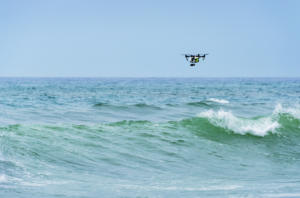
NOAA Expands its Data Drone Fleet

via Shutterstock
As it ramps up a national AI strategy, the U.S. government is beefing up its drone fleet to collect ever-greater amounts of environmental data.
The U.S. National Oceanic and Atmospheric Administration (NOAA) said this week it will use new funding to launch its Unmanned Systems Operations Program. Congress appropriated $12.7 million in fiscal 2020 to establish the earth science data initiative. Those funds will be used to expand current operations that use drones to collect environmental data on seafloor and habitat mapping as well as fishery assessments and ocean surface observations used for hurricane forecasting.
Those efforts would also augment NOAA’s strategy for leveraging AI and machine learning technologies to improve its processing, interpretation and utilization of its far-flung Earth observations.
The agency said it has increased use of unmanned aircraft equipped with sensors tenfold since 2012. The new funding would allow it to expand its drone fleet as a “force multiplier” for collecting environmental data.
The funding increase also helps NOAA comply with a 2018 law requiring the agency to coordinate research with the U.S. Navy and other federal agencies along with industry and university data scientists. Those efforts include acquiring unmanned marine systems and assessing environmental data collected by those sensor platforms.
NOAA’s Aircraft Operations Center in Lakeland, Florida, will continue to support the agency’s unmanned aircraft activities. A new facility being built by the Mississippi State Port Authority in partnership with the University of Southern Mississippi in Gulfport, Mississippi, will support unmanned maritime systems, the agency said Tuesday (March 31).
Meanwhile, NOAA and the Navy are jointly evaluating unmanned system technologies for ocean research applications under an existing program, the Advanced Naval Technology Exercise. The five-year-old effort allows scientists and engineers to test experimental technologies for ocean research.
As huge volumes of environmental data are collected for analysis, NOAA said it is exploring greater use of AI technologies in conjunction with its expanding drone fleet. Among the goals is accelerating data analytics. The agency released its AI strategy in February.
Specific AI use cases cited in the NOAA strategy include aerial and underwater surveys using autonomous platforms and “robotics for deep-sea exploration.” Others included “operation of unmanned systems for bathymetric mapping, habitat characterization, hydrologic, oceanographic, atmospheric, fishery, ecosystem and geographic surveys.”
Recent items:
NOAA Updates its Massive Climate Dataset
NOAA Announces New Collaboration with AWS, Google Cloud and Microsoft






























